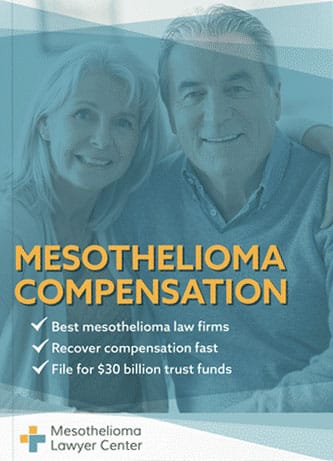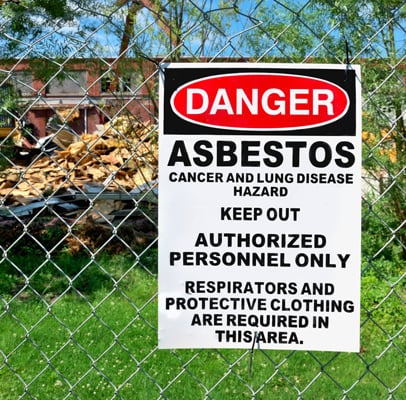Many companies used asbestos and made asbestos products in the past, putting workers and consumers at risk for mesothelioma and other illnesses. Court documents in lawsuits have proven over and over again that companies covered up the dangers of asbestos to save costs and avoid litigation.
If you or a loved one have mesothelioma, asbestosis, or asbestos-related cancer, you may be eligible for a large amount of compensation. Currently, there is over $30 billion in trusts set up for those who have been diagnosed with an asbestos-related illness. Fill out our form to get a free Financial Compensation Packet. You’ll learn about the experienced mesothelioma lawyers in your area, how to get paid in 90 days, how to file a claim for the asbestos trust funds, and more.


FREE Financial Compensation Packet
- Info on law firms that will recover your HIGHEST COMPENSATION
- Learn how to get paid in 90 days
- File for your share of $30 billion in trust funds

A Long History of Hiding Asbestos Risks
- Asbestos was first found to be detrimental to human health in the 1800s. In 1928, physicians coined the medical term asbestosis to describe the lung symptoms resulting from asbestos exposure.
- In the 1930s, doctors and researchers began to connect asbestos exposure to lung cancer. At the same time, they began to identify more cases of mesothelioma, a rare cancer only caused by exposure to asbestos.
- It would still be many more years before regulations protected workers from the asbestos dust that caused asbestosis and other illnesses.
- Many companies, but especially those that mined, produced, and supplied asbestos, had a vested interest in hiding the known dangers of asbestos exposure.
- Executives in asbestos companies actively covered up health information related to asbestos. Some companies even altered the insurance documentation that warned of the dangers of asbestos exposure.
- These companies hid the evidence and knew of the inherent risks. Many didn’t even reduce the production and use of asbestos in the slightest bit.
- As early as the 1930s, victims started filing lawsuits against their employers after being diagnosed with asbestosis. Companies began settling the lawsuits on the condition that no more lawsuits would come about regarding asbestos.
- After the initial asbestos lawsuits, employees underwent health screenings with their employers’ consent. It has been documented that many employers once again covered up the evidence by altering the health study results.
- The issues didn’t go unnoticed by physicians, who then were discovering that not only did asbestos cause lung issues and difficulty with breathing, but also lung cancer.
- Eventually, after decades, the complete truth about asbestos came to light. Workers began suing companies for damages and winning millions in compensation. Many companies went bankrupt and set up asbestos trust funds to compensate victims.
Companies That Knew About and Hid Asbestos Dangers
Many companies hid the risks of asbestos exposure from workers and consumers. Some of the biggest cover-ups occurred in companies that supplied asbestos and made asbestos products. Insurance companies that stood to lose a lot of money were also involved in cover-ups.
Johns Manville
Johns Manville was once the largest producer of asbestos materials, mostly made for the construction industry. It also mined and supplied asbestos to other companies.
In 1943, after a six-year study and research on asbestos, Dr. LeRoy Gardner of the Saranac Laboratory in New York provided the Johns-Manville Corporation with the detailed results of his research. He found asbestos to be carcinogenic, meaning that it causes cancer.
At the Johns-Manville Corporation’s request, none of the findings were made public nor available to any workers employed at Johns-Manville. In addition, the asbestos industry ensured that Dr. Gardner’s results were suppressed by altering and creating a false report.
Lewis H. Brown, who became company president in 1929, played a big role in Johns Manville’s asbestos cover-up. In a deposition that took place in the 1980s, evidence came to light that he actively and callously disregarded worker health to save money.
More than one doctor notified Brown and other company executives of asbestos dangers and illnesses in workers. They ignored, covered up, and hid this information from workers for decades.
Raybestos-Manhattan
Raybestos-Manhattan made asbestos textiles and friction products, like automobile brakes and clutches. The company was found to have collaborated with Johns Manville in the asbestos cover-up.
The information came from the Sumner Simpson Papers. Simpson was the president of Raybestos-Manhattan in the 1930s and 1940s. Simpson and his company worked with Johns Manville to convince an insurance company to alter a study that showed asbestos exposure could cause fatal asbestosis.
The papers, which came to light during lawsuits, also showed that Simpson pressured magazine journalists to avoid publishing articles that showed asbestos in a bad light.
Bendix Corporation
Bendix, which is today a subsidiary of Honeywell, made brakes and clutches with asbestos for decades, beginning in 1939. A Bendix executive communicated with an executive at Johns Manville’s Quebec asbestos mine about a report outlining the dangers of asbestos.
The Johns Manville executive encouraged him not to take it seriously. The mine also sent Bendix misleading reports about asbestos dangers.
Bendix did not follow up on the concerns about asbestos coming from Johns Manville mines. It was misled by the larger company but also played its own role in the cover-up. Bendix still made auto parts with asbestos as late as the 1990s.
Metropolitan Life
The Metropolitan Life Insurance Company insured several companies that supplied or used asbestos. It participated with many of those companies in covering up information about asbestos health risks.
As early as 1932, Metropolitan Life knew about the high levels of asbestos fibers in the Johns Manville plant in Manville, New Jersey. It helped block inspections at the facility that might have brought the dangers to light. It also actively lied to government officials, downplaying the degree of asbestosis in workers at the plant.
A physician working at an Illinois Johns Manville plant suggested to Metropolitan Life that the company hang signs warning workers of the dangers of asbestos. The company’s employee, Dr. Anthony Lanza, objected to the idea, wanting to avoid legal problems.
Dr. Lanza already knew about the dangers at that time due to his research. His study from the 1930s found that half of workers exposed to asbestos had signs of asbestosis. He found that 87% of workers exposed for longer had signs of lung diseases.
Babcock & Wilcox
Even later, in the 1970s, companies were still covering up vital information about asbestos in their products and its risks. Babcock & Wilcox made boilers and related products with asbestos insulation.
A memo from the company written in 1978 shows that the company knew about the dangers of asbestos and that it actively violated OSHA safety guidelines for workers. In the memo, the company acknowledged the violations and stated it would investigate but also decided not to warn workers.
Johnson & Johnson
A more recent example of asbestos health cover-ups comes from Johnson & Johnson, which makes products with talc. Talc is a natural mineral that is often contaminated with asbestos when mined. The company is supposed to refine the talc to remove any asbestos and make it safe for consumers.
Many people who used Johnson & Johnson talcum powder products for years have come forward with allegations that asbestos in them caused cancer. Many of these victims are women who developed ovarian cancer.
An investigative report published in 2018 found that Johnson & Johnson knew about asbestos in its products as early as the 1970s. Company documents show that executives knew about testing that found asbestos in talcum powder but did not report the results.
The company eventually ended sales of talcum powder products, but not before facing thousands of lawsuits over asbestos exposure and cancer.
Regulating Asbestos
By 1971, it had already been over 40 years since the first asbestos-related lawsuits.
Because of covert actions, like companies persuading publications not to write about the dangers of asbestos, it took too long for asbestos to be recognized as a dangerous product.
The Occupational Safety and Health Administration (OSHA) finally took notice and regulated the use of asbestos.
At first, OSHA mandated an emergency temporary standard (ETS) for exposure to asbestos dust in December of 1974. Shortly after, the temporary standard became a permanent standard.
Ultimately, the details regarding the dangers of asbestos became widespread, and it became obvious that businesses had been suppressing this information for decades.
The dangers of asbestos became so prevalent that in 1979, the EPA announced it would regulate asbestos under the Toxic Substances Control Act (TSCA).
Yet, after a stampede of protests stating that too many people would be out of a job, the EPA decided not to pursue the regulations.
Nonetheless, after a 10-year study on the dangers of asbestos and how it affects humans, the EPA finally banned the use of all asbestos in 1989.
However, asbestos industry members appealed the ban, and unfortunately, they won. Asbestos is not completely banned in the U.S.
Companies Put Profits Over Worker Health
Although it was established that asbestos was dangerous decades before the EPA’s regulation, companies continued to stifle any information regarding the hazards of the mineral.
Even after physicians, scientists, and even asbestos companies provided details of the dangers after conducting studies, companies still wouldn’t scale back on asbestos usage or inform workers of the dangers. The reason behind the great cover-ups comes down to money.
When Lewis Brown, the president of Johns Manville, was asked if he would let his workers die if it meant continuing to use the mineral, he replied, “Yes; we save a lot of money that way.” This statement came out in a 1984 deposition.
Records show that in 1966, the director of purchasing at Bendix, an asbestos manufacturing company, stated, “If you have enjoyed a good life while working with asbestos, why not die from it?”
Many of these companies have had to pay for the harm they caused workers. If you have an asbestos illness, a mesothelioma lawyer can help you take legal action and seek compensation.
Getting Legal Help for Asbestos Exposure
Keep in mind that you may be eligible for considerable compensation if you or a loved one have been diagnosed with mesothelioma, asbestosis, or asbestos-related cancer. Don’t forget to fill out our form for our free Financial Compensation Packet, filled with information on the experienced asbestos and mesothelioma attorneys in your area.

Paul Danziger
Reviewer and EditorPaul Danziger grew up in Houston, Texas and earned a law degree from Northwestern University School of Law in Chicago. For over 25 years years he has focused on representing mesothelioma cancer victims and others hurt by asbestos exposure. Paul and his law firm have represented thousands of people diagnosed with mesothelioma, asbestosis, and lung cancer, recovering significant compensation for injured clients. Every client is extremely important to Paul and he will take every call from clients who want to speak with him. Paul and his law firm handle mesothelioma cases throughout the United States.
References
- Richards, B. (1978, November 12). New Data on Asbestos Indicate Cover-Up of Effects on Workers. The Washington Post.
Retrieved from: https://www.washingtonpost.com/archive/politics/1978/11/12/new-data-on-asbestos-indicate-cover-up-of-effects-on-workers/028209a4-fac9-4e8b-a24c-50a93985a35d/ - U.S. Environmental Protection Agency. (2023, October 10). Asbestos Laws and Regulations.
Retrieved from: http://www2.epa.gov/asbestos/us-federal-bans-asbestos - Lilienfeld, D.E. (1991, June). The Silence: The Asbestos Industry and Early Occupational Cancer Research–A Case Study. Am. J. Public Health. 81(6), 791-800.
Retrieved from: https://www.ncbi.nlm.nih.gov/pmc/articles/PMC1405162/ - Formuzis, A. (n.d.). Deadly Deception: How the Asbestos Industry Covered Up the Danger for Decades, and Continues to Evade Accountability Today. EWG Action Fund.
Retrieved from: https://www.asbestosnation.org/deadly-deception-how-the-asbestos-industry-covered-up-the-danger-for-decades-and-continues-to-evade-accountability-today/
